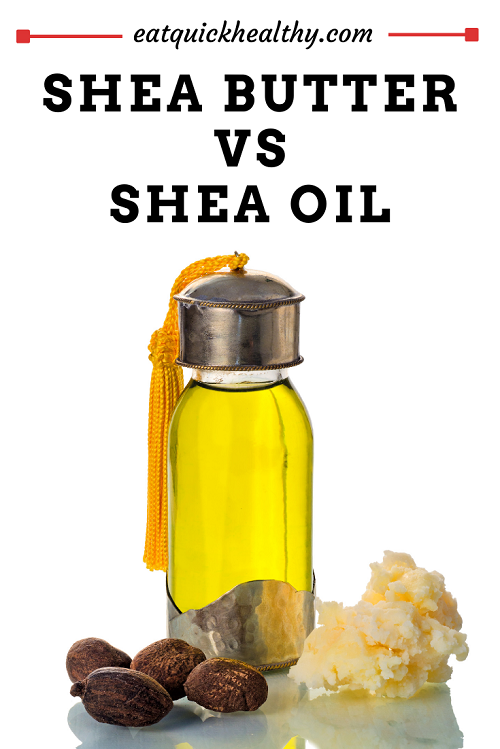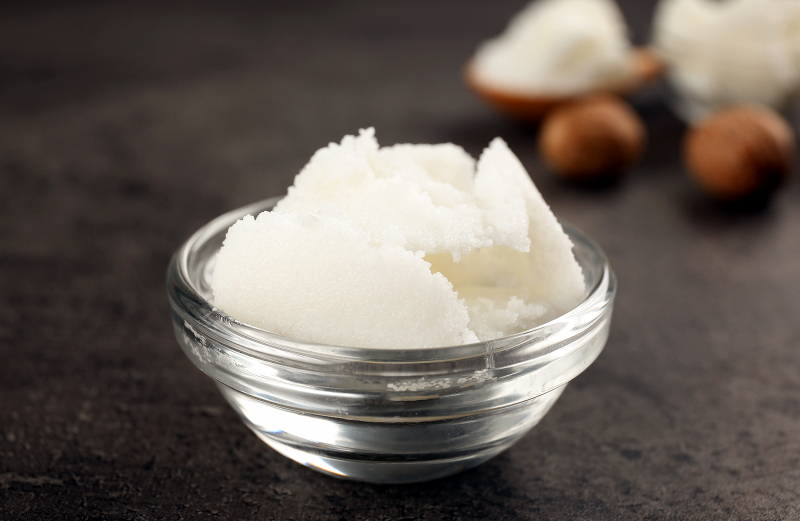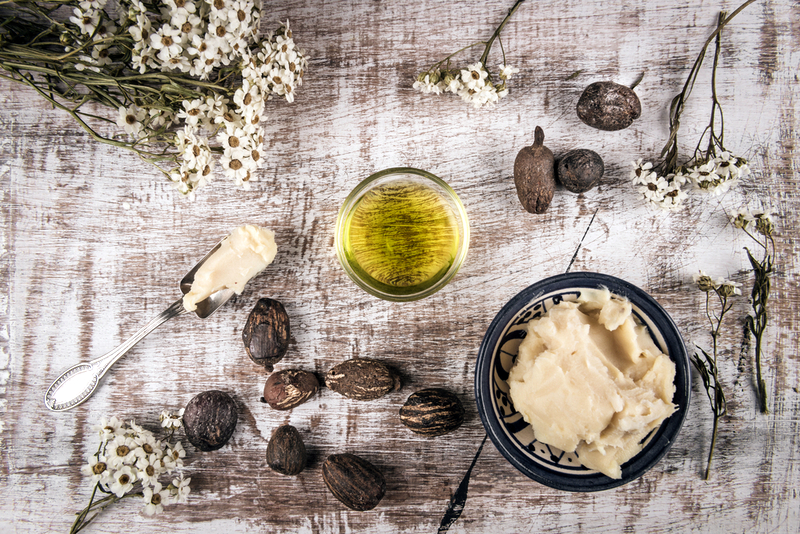Shea butter is a well known and popular ingredient in skin and beauty care products. It’s been used for many centuries for these purposes.
However, did you know that you can also buy shea oil?
Also known as shea nut oil and shea butter oil, shea oil is an extract in the process of making shea butter and also has many benefits in skin, hair and beauty care.
If you are wondering what the differences are between shea butter and shea oil, you are in the right place! In this guide, I share a full comparison of shea butter vs shea oil including exactly what each of these products are and how they are made, the benefits of each and everything you need to know to know which is best for your needs.
Let’s start!

What Is Shea Butter?
Shea butter is a fantastic skin super food, popular in skin and beauty care products. It originates in West Africa where shea trees are native and shea butter itself is made from the fat extracted from seeds that come from these trees inside fruit.

The first step in making shea butter is to collect these seeds by removing them from their outer shells. They are then left to dry.
The dried seeds are then turned into shea butter either using a process which involves high-heat and chemical solvents or a more natural process which does not involve these things.
Using heat and chemicals is the quickest and easiest way to produce shea butter leading to a cheaper product. However, producing shea butter this way leads to an inferior product that loses most of its nutrients. This makes it less beneficial for skin and beauty treatments. This is called refined shea butter.
The alternative is called unrefined or raw shea butter. This is often produced by hand using the process below.
You can read more about the differences between refined and unrefined (or raw) shea butter here.
After the seeds are dried, they are ground into a powder which is then roasted. This roasted powder is then ground again to form a viscous substance.
This is then kneaded while adding water before being whipped while adding more water. This process forces the oils to coagulate on the surface where they can be removed.
They are then boiled which not only removes any remaining water but also brings any impurities to the top where they can be removed.
Finally, it is strained and left to cool. It solidifies as it cools into a cream-like consistency. It’s an off-white/ivory color and has a smoky and nutty smell.
Click here to buy shea butter.

Is Shea Butter An Oil?
Generally, shea butter is considered an oil. Some definitions of oils require them to be liquid at room temperature which shea butter is not. So it fails if you are looking for this requirement.
What Is Shea Oil?
Shea oil is actually a possible extract from the process of making shea butter. It is also sometimes called shea butter oil or shea nut oil – these terms can be used interchangeably.
You can think of shea oil as full of the goodness of shea butter without the elements of shea butter that makes it solid and wax-like like butter. It’s like a concentrated version of all the best nutrients in shea butter.
It does have a slightly different make up to shea butter, however, with differing amounts of fatty acids which are discussed more below. The main difference is the amount of stearic acid, which gives shea butter its butter-like consistency, is less in shea oil
Shea oil is liquid at room temperature. It is a slightly yellow color and also has a mild smoky and nutty smell.
How To Make Shea Butter Oil
The process to make liquid shea butter oil is exactly the same as shea butter as described above up to the point where the substance is being kneaded and whipped.
At this stage, the oils don’t just coagulate at the surface, but there is some separation between the oil matter and the more solid butter matter. The shea oil can be collected here while the rest of the substance can be boiled to continue making shea butter.
Benefits Of Shea Butter
Shea butter has many benefits and has been used for many different things over many centuries. This is thanks to how nutrient-rich it is along with the useful fatty acids it contains.
For a start, shea butter has anti-inflammatory and pain relieving properties which is how it first started being used a long time ago. It has been used for things as diverse as ulcers and congestion.
Today, shea butter is primarily used in skin care – although these anti-inflammatory properties still play a part in why it’s so great for your skin.
The main ingredients in shea butter are the fatty acids linoleic, oleic and stearic acid. They absorb quickly in the skin and help with dry skin, rashes, peeling and other problems. Shea butter is an emollient which means it softens dry, rough and flakey skin. It helps it not just look better but also feel better. It will fill in open spaces in your skin to smooth it out.
It’s also an occlusive agent so it will form a protective layer on your skin while hydrating underneath.
The vitamin E and D content in shea butter along with the fats help with skin regeneration meaning this is also a useful ingredient for anti-aging formulations. Shea butter can also help with wound care.
Shea butter is perhaps my favorite, must-have ingredients in skincare products. It’s all natural with just so many benefits.
You can read more about how shea butter helps hair here or feet here.
Benefits Of Shea Butter Oil
Shea butter oil benefits are very similar to that of shea butter thanks to its similar make up. It contains many of the same acids and vitamins but since the amount of these differs, it does lead to different results.
Below are more details on shea oil benefits for the hair and skin. Organic shea oil can also help with congestion by rubbing some near your nose.
Shea Butter Oil For Skin
Using shea butter oil for face and skin is a great way to moisturize and hydrate your skin and shea oil is a great moisturizer. It absorbs into the skin easily and is especially great on dry skin.
It also has anti-inflammatory properties which make it great for applying on inflammatory skin conditions or many rashes. It can also be beneficial to apply shea oil around eyes to help with bags and wrinkles.
All these great properties also mean that shea oil can help on cracked heels and other damaged skin.
Shea oil can also make great massage oil. Thanks to its quick absorption in the skin, it can help sore muscles as well as hydrate the skin while you massage.
You can also apply shea butter oil for lips to help moisturize them.
Shea Butter Oil For Hair
Using raw shea butter oil for hair can help de-frizz and control your hair making it a great choice for curly hair. With any type of hair, however, it can hydrate the hair strands and help produce healthier hair.
There are also benefits to rubbing shea butter hair oil into your scalp. This can help any dry skin problems, like dandruff, and hydrate your scalp and hair roots.
While there is no proof that using shea butter oil for hair growth will be successful, shea oil can promote an overall healthier environment on your scalp and head which should lead to the best opportunity for hair growth.

Shea Butter Vs Shea Oil
If you have read up to here, it may be confusing whether you should use shea butter or shea oil as they are quite similar. So let’s find out who is the winner of shea oil vs shea butter!
Appearance And Aroma
Shea butter and shea oil appear quite different, mainly because shea butter is a solid at room temperature and shea oil is a liquid. Shea butter has a hard cream-like consistency and shea oil appears like any vegetable oil.
Raw shea butter is an off-white/ivory color and shea oil is a slight yellow color.
Both shea butter and shea oil have a smoky, nutty smell. However, this is stronger in shea butter. It is much milder in shea oil and it’s easier to mask with fragrances and essential oils.
Note that if you want to use refined shea butter, this does not have a smell and is a white color but it’s not recommended due to all the nutrients that are lost in the refining process.
Nutrients
Both shea butter and shea oil are nutrient rich. They do end up with different amounts of fatty acids and nutrients though.
The following table shows you the difference in the four prime fatty acids that make up shea butter and oil.
| Fatty Acid | Raw Shea Butter | Shea Oil |
| Oleic acid | 46% | 59% |
| Stearic acid | 43% | 27% |
| Linoleic acid | 7% | 9% |
| Palmitic acid | 4% | 5% |
The prime difference between shea butter and oil are the amounts of stearic and oleic acids. Oleic melts at a lower temperature so it becomes liquid more easily and is removed from the butter which is why more of this ends up in shea oil. Oleic acid is highly moisturizing and easy to absorb.
Stearic acid is what creates the waxy consistency of the solid shea butter which is why it is higher in shea butter.
Easiest To Work With
If you are using shea butter or shea oil as an ingredients in a skin or hair care product you are creating, there is a clean winner when it comes to which is easier to work with – shea oil.
As it’s already liquid, it’s easy to use in recipes with no melting or whipping required. It’s also easy to add fragrances and essential oils too.
However, sometimes it can be handy to use shea butter because it is a solid as it will help whatever you mix with it be solid too which can be desirable.
Raw Shea Butter can have a gritty or grainy texture when melting and then cooling it again which can show up in your skincare products. Shea oil does not have this problem. It has a lighter, less greasy feeling in products with no graininess.
If you want a product you apply directly, shea oil also wins since it’s super simple to rub right into your skin. Shea butter needs warming between your hands first and is tough to apply places like hair strands which aren’t warm.
Better Moisturizer
Since the prime use of shea products is generally to moisturize the skin, it’s handy to know which does the better job.
The reality is both shea butter and shea oil make great moisturizers and are good at hydrating your skin.
However, shea butter is the only one that can form a great protective shield for your skin while it hydrates underneath. So if you want this protective coating, pick shea butter.
Shea oil does absorb faster, however, and leaves less greasy feel on your skin.
Price And Availability
Shea butter is more readily available and generally cheaper than shea oil.
And the winner is….
Really, it depends what you are looking for. Read the benefits of each above and the comparisons here and then work our whether shea butter or shea oil is best for your needs.
Conclusion
I hope you have found this guide to shea nut oil vs shea butter useful with everything you need to know to pick the right product for you.
The reality is that both
The choice is yours!
Click here to read more about what shea butter is and here for how to use it on skin for best results or how it compares to coconut oil here. You can also find all our other shea butter guides here.

![Shea Butter Vs Shea Oil [Must Read] shea butter vs shea oil](https://eatquickhealthy.com/wp-content/uploads/2021/11/shea-butter-vs-shea-oil-768x513.jpg)


Comments are closed.